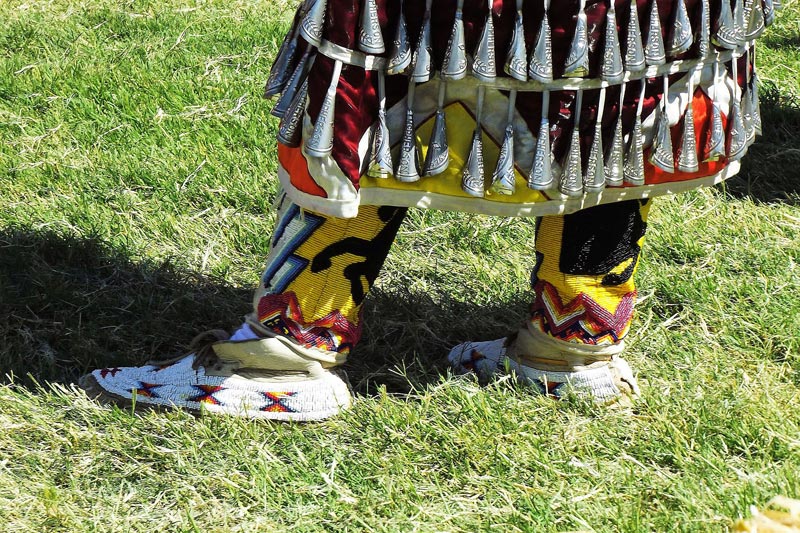Are you of Native American descent and looking to have a wedding that is true to your culture?
Native Americans have many beautiful wedding traditions that are well-worth incorporating into your big day. What kinds of traditions are there?
Check out this guide to discover the Native American wedding traditions that will help you stay true to your culture.
Keep in mind, there are many Native American tribes, each with its cultural traditions and customs. Therefore, we have covered a few of the significant areas of the wedding ceremony, but this is not an exhaustive list.
Wedding Dress and Groom’s Attire
Just like any other type of wedding, the bride and the groom of a Native American wedding wear extra special attire, reflecting their culture and the significance of the big day. Their wedding attire is often referred to as the regalia, which are the insignia or emblems of royalty.
Native American brides typically wear red or bright colors for their wedding day.
In some cases, specific colors are woven into the bride’s attire, symbolic of the different cardinal directions (east, west, north, south). Jewelry is seen as a shield against evils, including hunger, poverty, and bad luck.
Sometimes, these dresses are passed down from one generation to the next.
Depending on the tribe, type of wedding, and location, some wedding couples might wear modern wedding clothing (i.e., a white dress and tuxedo). Ceremonial clothing varies greatly from tribe to tribe. Therefore, it is important to do your research and know your tribal heritage to determine what ceremonial clothing would be appropriate.
Here are some examples:
Cherokee
In Cherokee tribes, brides wear all white dresses and white moccasins. In colonial times, dresses were typically made from pieces of cloth that other tribal women tore into rectangles or squares.
Today, some women wear a traditional style tear dress that has a white calico pattern. The grooms typically wear a red shirt, black pants, and moccasins, and their outfits are adorned with ribbons.
Hopi and Delaware
Some of these tribes wear traditional deerskin clothing as a part of their bridal attire. A Hopi woman’s bridal wear would often include thick leggings, a dark dress, and a white blanket draped across her shoulders. Delaware women would wear a wedding dress with a knee-length deerskin skirt. Wampum beads would be worn on her head. The bride might opt for a shell or beaded necklace as well, but no other jewelry was included. Then her face would be painted with various colored clay as part of her traditional dress.
Algonquin
In the Algonquian tribes, the bride and groom wear traditional clothing that is made by hand. The bride would wash in water (lake, river, pond, or ocean) on the morning of the wedding to be blessed by the spirit of the Earth.
Northern California Tribes
Tribes in this area typically wear wedding attire that incorporates symbolic colors. Blue, yellow, and black are typical symbolic colors of tribes in this area and often incorporated into ceremony attire.
Jewelry
Jewelry is a major component of many Native American wedding ceremonies. While they historically do not wear wedding rings, they do often incorporate metals and gems, such as sterling silver and turquoise into their wedding attire.
Typically, the lady’s ring is made from turquoise and the groom’s ring is made from opal.
Music and Dance
Music and dance are another big part of Native American wedding ceremonies.
Historically, drums, flutes, and vocals have been used during weddings and other special ceremonies. Some tribes also have special ritual dances that are performed during weddings. The type of dance performed can vary greatly from tribe to tribe.
The Wedding Vows
When it comes to wedding vows, each tribe has different sayings and events that occur.
One of the vow-exchanging processes is referred to as the Rite of the Seven Steps. The creation of the Rite can be attributed to many different tribes throughout the nation.
The Seven Steps revolves around symbolism, and it involves the bride and the groom stepping clockwise around fire as a symbol of warmth and light. The clockwise rotation symbolizes the light, while the fire symbolizes the warmth.
To perform the Rite, the couple approaches the fire as their family members and friends form a circle around them holding hands. The groom steps forward first and recites his vow, and then the bride follows with her vow.
They will take 7 steps each and recite a new vow with each step. In some variations of the Seven Steps, the bride and groom exchange small gifts with one another.
For example, the groom may give the bride a feather as a symbol of honesty and truth.
The Ceremony
Traditional wedding ceremonies sometimes include several or more smaller ceremonies within one larger one. Here are some examples of smaller ceremonies that take place within the larger ceremony:
Basket Ceremony
During this ceremony, the bride and the groom exchange baskets that are filled with gifts. These baskets are symbols of the dowries that were once traditionally exchanged between the bride and groom’s families.
Gifts may consist of corn, bread, and meat.
Another basket ceremony is when a corn mush, created from white and yellow cornmeal, is eaten first by the couple and then by the groom’s family.
Water Ceremony
In some Navajo weddings, the bride pours water on the groom’s head as a representation of their new union. Both the bride and the groom will also wash their hands to remove old wrongdoings and memories.
Vase Ceremony
This ceremony involves filling a vase with two holes with water on either side. Each hole represents the separate lives of the couple, and the handle represents the bridge between them. The bride and the groom then drink the water from each side as a representation of their union.
If the bride and groom are able to drink simultaneously without spilling the water, it is considered good luck in terms of communication and fortune throughout their marriage.
The Location
Native American weddings often take place outdoors. There are sacred places all over the country, including:
- The San Francisco Peaks in Arizona
- The Sweetgrass Hills in Montana
- Bull Lake in Wyoming
- Bear Butte in South Dakota
- There are five sacred hills near Cedar Bluffs, Nebraska
- Bighorn Medicine Wheel in Wyoming
- The Pipestone National Monument in Minnesota
Many Native American wedding ceremonies also take place in national parks.
The Food
As we have touched on earlier, food is sometimes exchanged as a part of the vows. or as a representation of the exchange of wedding rings. In the Cherokee tribe, for example, the groom gives the bride a cut of deer meat. This is to symbolize that the groom will be a good hunter and provider. Brides sometimes offer corn or frybread to symbolize that they’ll be good homemakers.
Modern couples often adapt these exchanges to fit with their own relationship dynamics.
Of course, there’s also food for the guests during a Native American wedding. Nowadays, many weddings incorporate traditional Western fare. Oftentimes, you will find variations of corn, fry bread, beans, squash, pumpkin, meat stews, and venison.
In most weddings, the eating order prioritizes the elders, then the bride and groom, then family members, then the guests.
Which Native American Wedding Traditions Will You Incorporate?
Now that you know about these Native American wedding traditions, it is time to figure out which ones you want to incorporate into your wedding. Pretty soon, your big day will be here.
If you want some help planning your wedding, contact us today.
Wedding Details is your comprehensive guide to all aspects of your wedding. From traditional ceremonies to questions regarding the guests, our website offers you one place to do all your research.

